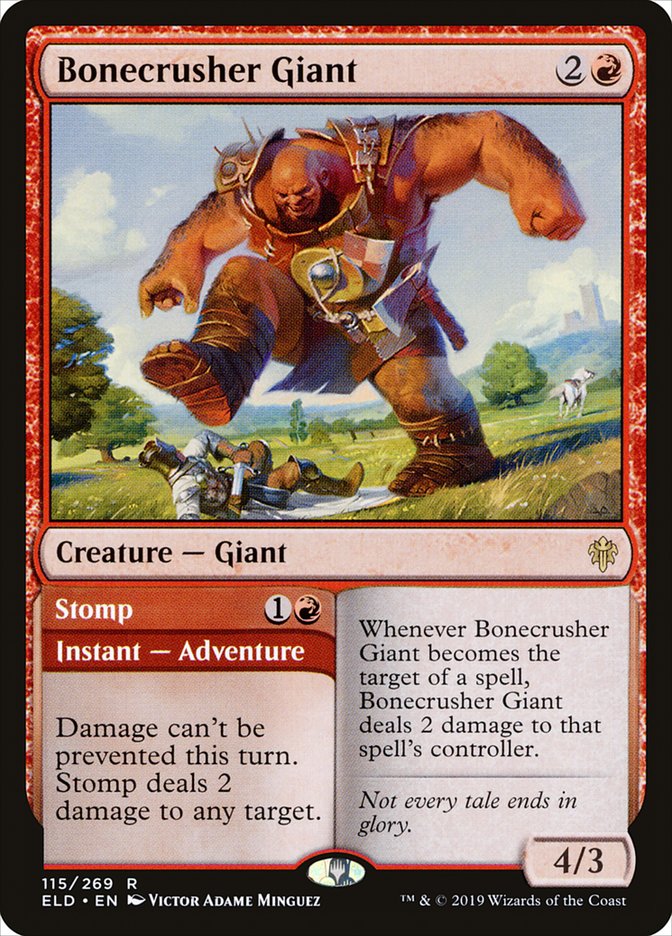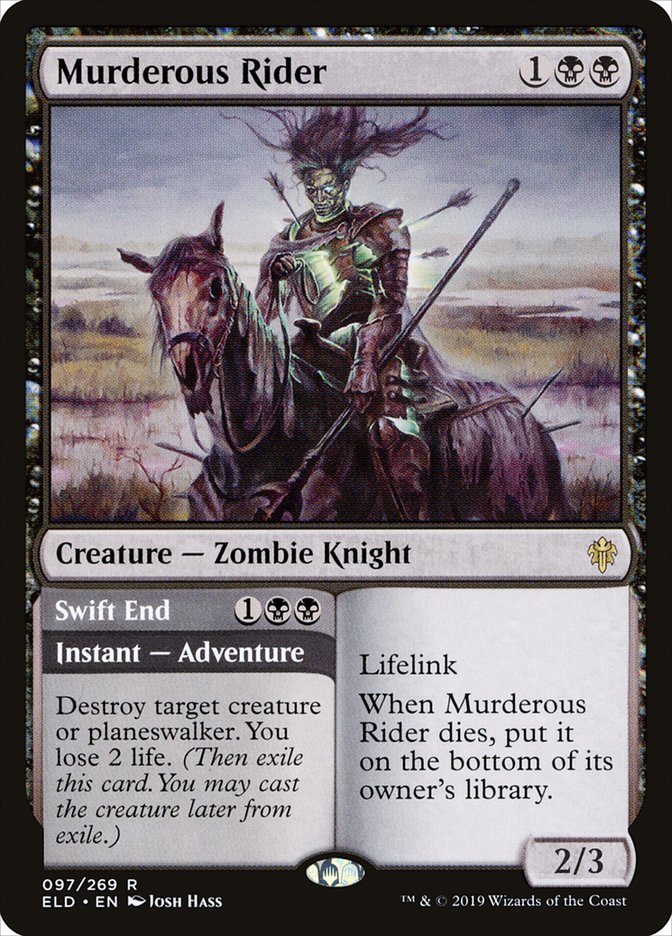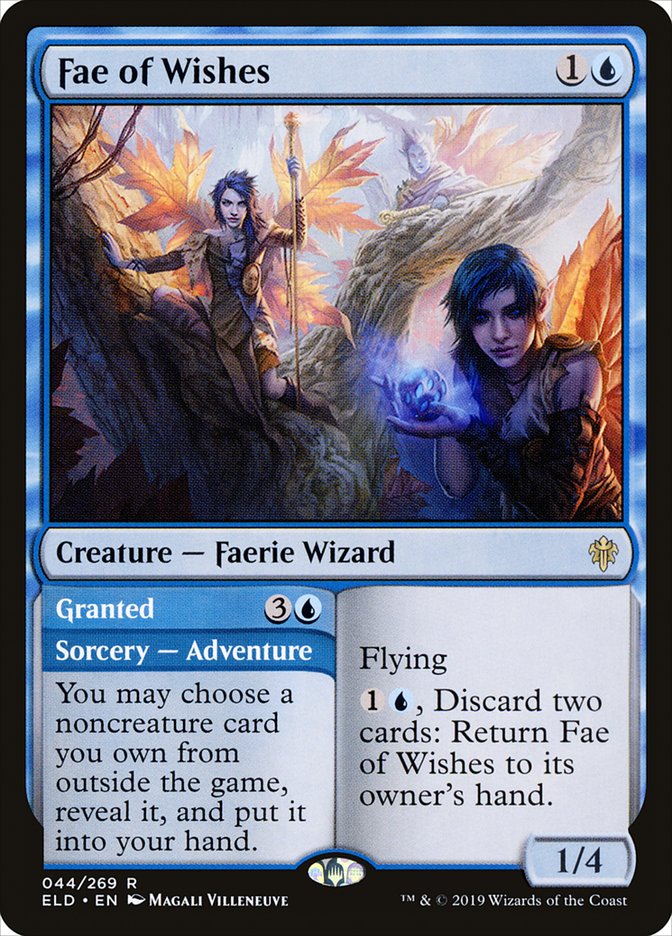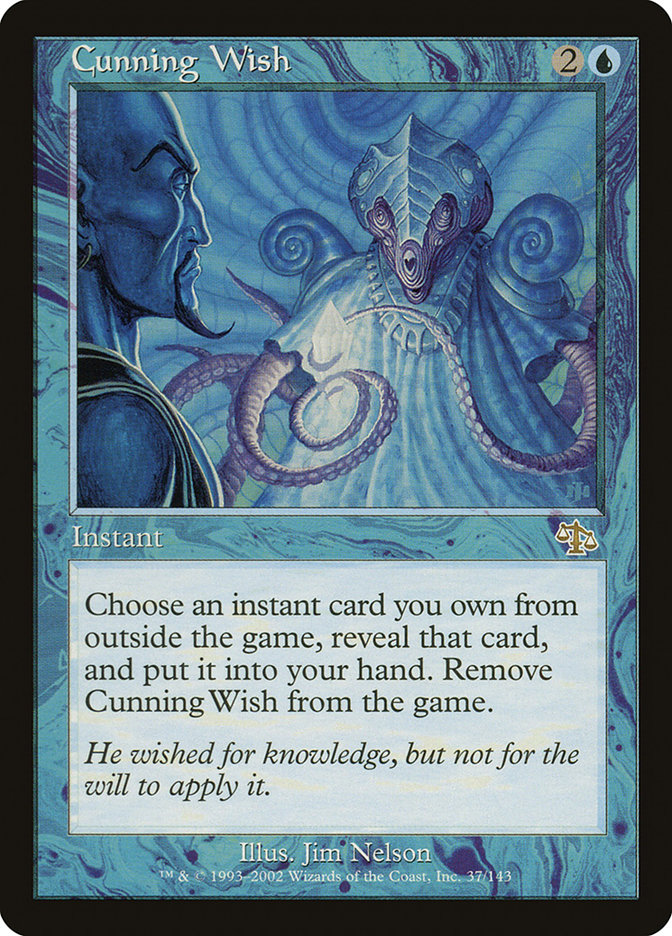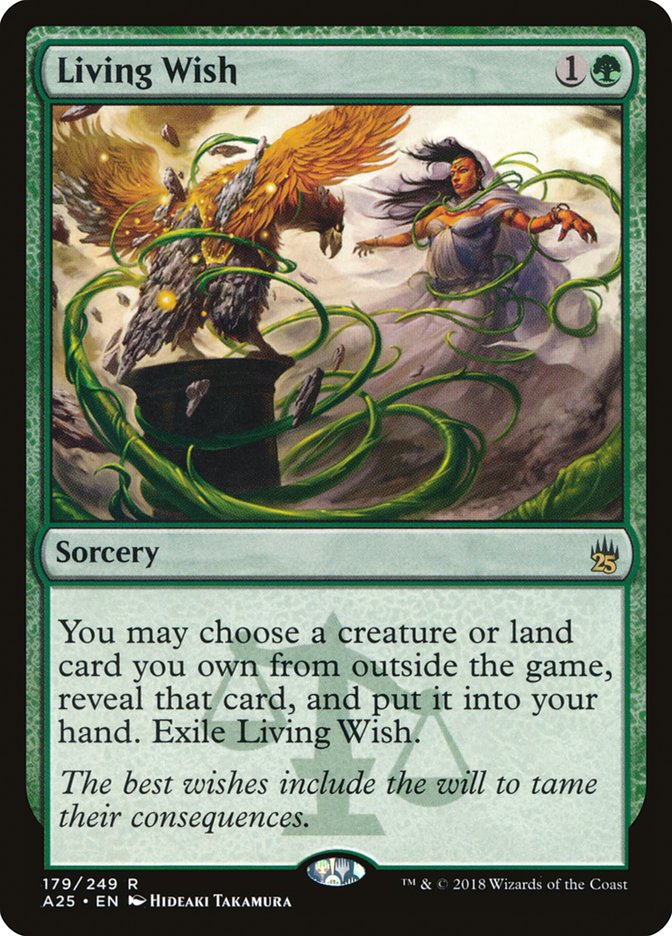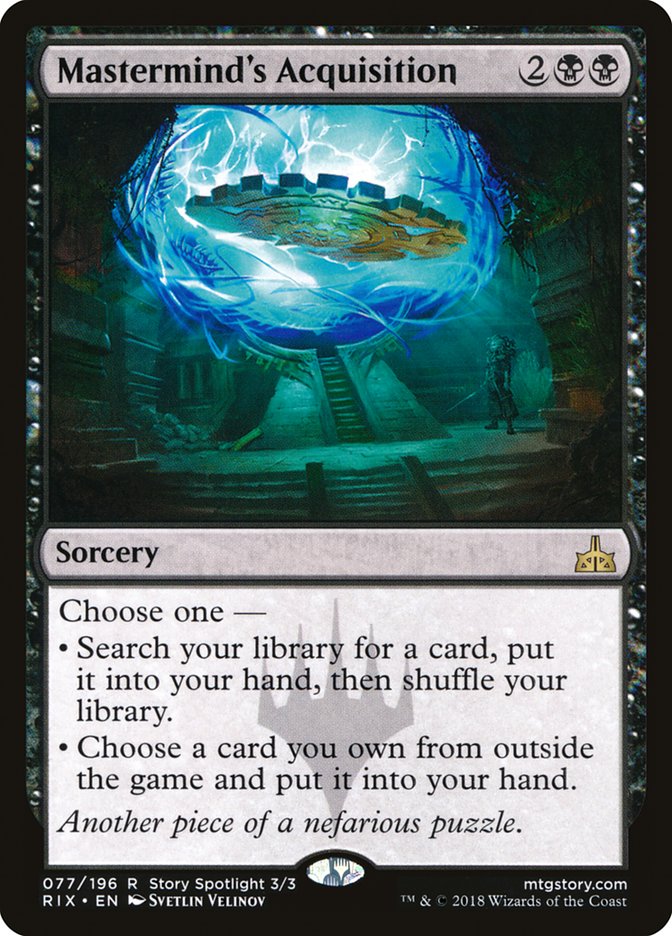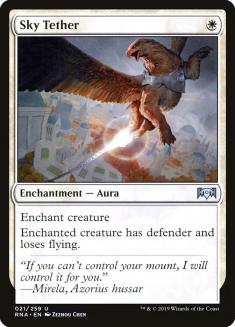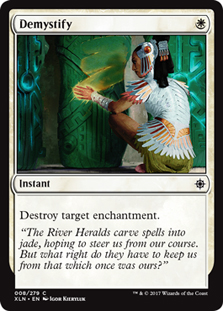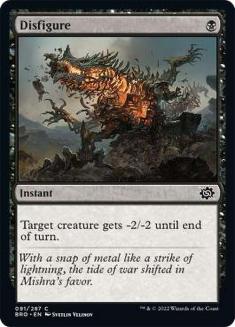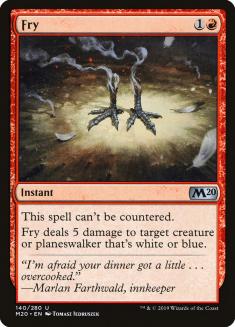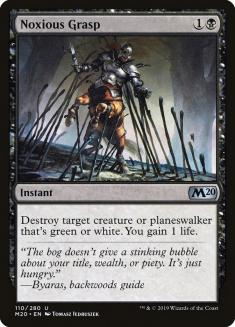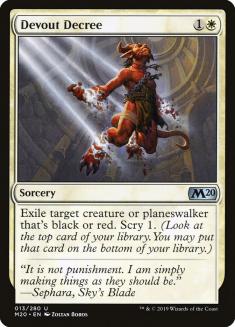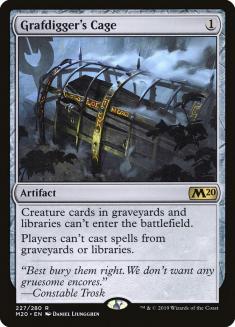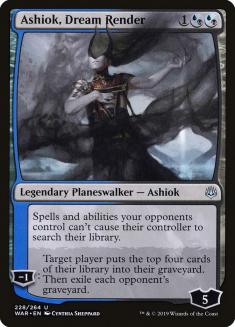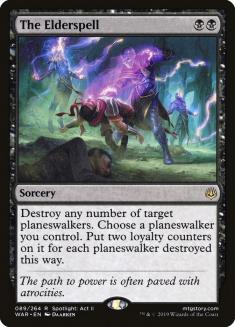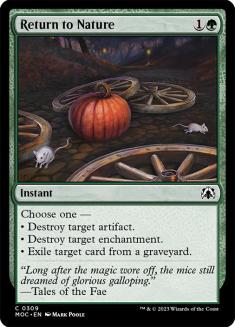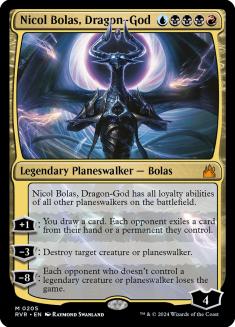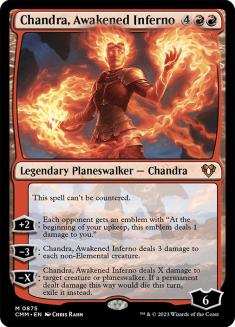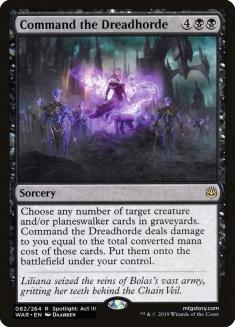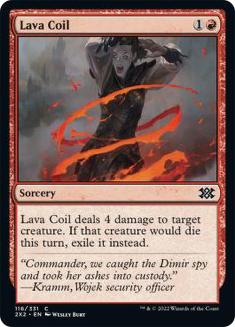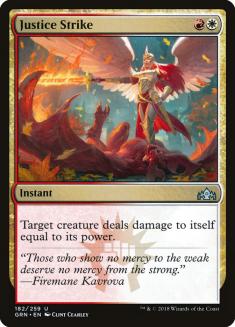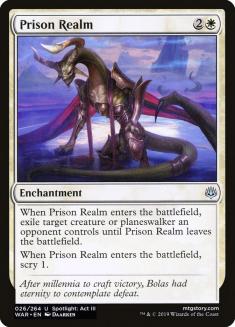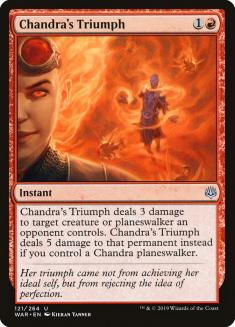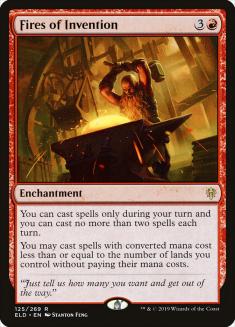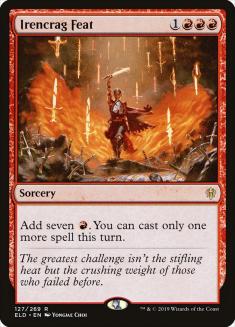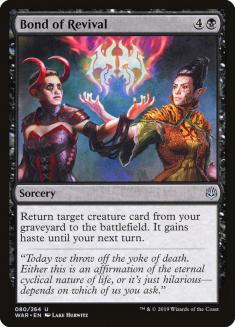There are several powerful adventure cards in Throne of Eldraine, and they are powerful for different reasons. While they are all stronger for being flexible, for some of them, that’s not why they are so great. Bonecrusher Giant, for example, is strong because it’s a removal spell and a creature, and if it was just one or the other, it wouldn’t be so good. Murderous Rider and Realm-Cloaked Giant are strong because they give you a bonus body on top of an already solid spell, but you’re very rarely going to cast their creature side first.
Fae of Wishes, on the other hand, is strong specifically because it’s flexible. You play it because you get either a creature or a Wish. Of course sometimes you’re going to get both, and that’s a nice bonus, but it’s not why you’re playing the card.
Fae of Wishes is basically a modal spell where one side is excellent against a certain type of deck (slow) and the other side is at least decent against the decks in the opposite side of the spectrum (aggro). This is extremely rare and extremely valuable. The issue with cards like Granted, the adventure on Fae of Wishes, is that they are powerful but clunky; you’d like to have access to them against a portion of the field, but you cannot because they run the risk of being too weak in certain matchups. Being able to turn them into a 1/4 flying blocker for two mana shores up exactly the matchups where a card like Granted isn’t good.
Of course a 1/4 flyer for two isn’t the best card ever, but it can be quite good in the right situation. Decks have sideboarded cards like Surgemare just as blockers before. There are several decks that don’t want you to play a card like this: White Aggro, Mono-Red Cavalcade, and Azorius Flyers, to name a few. Can you imagine casting a Turn 1 Scampering Scorcher and having your opponent cast a Fae of Wishes in response? That’s actually very bad for you. The reverse is also true. You wouldn’t want a 1/4 flyer for two against a control deck, but against that deck it’s a strong Wish effect instead.
Then there’s the “adventure” part of the card, which means you sometimes get both effects in one. Perhaps you drew Fae of Wishes late against an aggro deck, meaning you can get a powerful spell and a blocker next turn, or perhaps you cast Granted versus control and you’re now left with a creature that pressures Teferi, Time Raveler and Narset, Parter of Veils. If the game goes even longer, you can always bounce it yourself (either through its own ability or a Teferi of your own) and then cast Granted again.
Just like any Wish before it, Fae of Wishes demands you dedicate at least a portion of your sideboard to making it useful. What’s the best way to do that? There are five important elements in a Wish sideboard:
1. Cheap answers.
When you’re dealing with Wishes or Tutors, sometimes it’s helpful to be able to cast the card you searched for in the very same turn. When we played Mastermind’s Acquisition, one of the things we really valued was being able to turn it into a five-mana removal spell, for example, so that if your back was against the wall you could affect the battlefield in the same turn. Our removal of choice for this was Sky Tether, which is not a card you’d traditionally see yet fit the role we needed perfectly.
Fae of Wishes doesn’t need this mode that badly, because by itself it’s already a card you can cast and impact the battlefield; simply hardcast Fae of Wishes for two mana. You could, for example, play a card like Disfigure, but a lot of the time you’d rather pay two for Fae of Wishes than five for Disfigure anyway. Regardless, there are cards like Duress and Demystify that can often be played in the same turn and are good to have access to.
2. Answers to specific cards.
The ability to answer a problematic permanent in Game 1 is another powerful upside of Wishes, even more so than for Tutors, because you might not want to maindeck an answer that will have no targets against certain decks. Usually this means artifact or enchantment removal, but it can also mean answers to planeswalkers or graveyard hate.
In Standard, I think having a generic artifact or enchantment answer will be good. You could do with Demystify earlier on, since there were really no good artifacts, but some of the legendary artifacts from Throne of Eldraine might end up being popular, so I’d err on the side of being able to answer both. I’m also a huge fan of cards like The Elderspell that are situationally very powerful.
One card I particularly like as a Wish target is Grafdigger’s Cage. Grafdigger’s Cage shuts down any graveyard shenanigans, but it’s also the single best answer to Experimental Frenzy, because if they are both on the battlefield, then your opponent cannot cast spells at all. If they cast Experimental Frenzy and you answer it with Cage, they are forced to sacrifice their Frenzy. This is much better than simply killing it, as it stops all the Frenzies that are on the battlefield and all future Frenzies they draw, and wastes their mana on top of it.
3. Generically powerful effects.
If you have Fae of Wishes, you’re going to want at least one powerful effect that can win you the late-game. Top contenders are expensive planeswalkers (Nicol Bolas, Dragon-God; Ugin, the Ineffable; or Chandra, Awakened Inferno) and generically strong cards like Bolas’s Citadel and Command the Dreadhorde.
4. A variety of cards with similar effects.
When you have Fae of Wishes in your deck, you probably want to diversify your sideboarding a little bit. For example, imagine you’ve decided you want two expensive cards in your sideboard for control matchups; normally, you’d pick whichever one of Bolas’s Citadel and Command the Dreadhorde is better and play two copies. However, if you have Fae of Wishes in your deck, you might opt to play one copy of each, since there are situations in which you really want to Wish for one and not for the other, and the difference is small enough when you sideboard them in. The same could be true for, for example, two removal spells; it might be better to play one Lava Coil and one Justice Strike in your sideboard than two copies of either. Then, for Games 2 and 3, you can bring in all but one.
5. An additional card for your combo.
Sometimes you have a deck that really wants to find a specific card, and then you can play three copies of that card and four Fae of Wishes to effectively increase the total to seven copies. This could be the case, for example, for a deck that relies on having Fires of Invention on the battlefield.
So, where you can play Fae of Wishes?
- In best-of-one.
Best-of-one doesn’t have sideboarding, but that doesn’t mean players can’t submit a fifteen-card sideboard. This sideboard is useless, except if you have a card like Fae of Wishes in your deck. This means that, in best-of-one, these cards get much more powerful, as you can dedicate your entire sideboard to fueling them (since you never get to actually sideboard), which means you have access to almost anything you might want at no cost. During the first Mythic Invitational, which was best-of-one, almost every single Esper deck used Mastermind’s Acquisition to win through its sideboard. I expect Fae of Wishes to have a similar impact.
- As a defensive card / draw spell hybrid in a control deck.
This would be the place to get the most out of Fae of Wishes’s flexibility by having it be an early blocker versus aggro and a toolbox finder versus control. One potential home is Jeskai Superfriends:
Creatures (8)
Planeswalkers (16)
- 4 Teferi, Time Raveler
- 2 Kasmina, Enigmatic Mentor
- 1 Saheeli, Sublime Artificer
- 4 Narset, Parter of Veils
- 3 Sarkhan the Masterless
- 1 Ugin, the Ineffable
- 1 Chandra, Awakened Inferno
Lands (27)
Spells (9)

Fae of Wishes slots very well into this deck, since it actually wants a blocker on Turn 2 and a 1/4 flyer does a pretty good job of protecting your planeswalkers. The card you’re going to get the most in a vacuum is probably Sarkhan the Masterless, but you can have a wide array of removal spells and different kinds of disruption.
You can also have a land in your sideboard, as Fae of Wishes only cares if the card is a noncreature. I don’t know whether this is a useful thing to have, as it’s not the greatest use of a sideboard slot, but I think I’d like to start with a land in my sideboard so that I can guarantee I can cast my five- or six-drops in a deck like this (and then you can bring the land in against a control deck if you want).
The jury is still out on whether Bonecrusher Giant is a better removal spell than something like Chandra’s Triumph in this deck; my inclination is that it is, but there’s no way to know until the format gets more established. If everyone is playing creatures with three toughness, then you cannot afford to play Bonecrusher Giant, but if the early drops are all X/2s or X/1s, then it seems better to me.
- As a combo piece.
One part of Fae of Wishes that’s easy to overlook is the discard ability. Most of the time you’re going to want to use it to turn two bad cards into Granted, but there might be decks for which the discard effect is actually a benefit sometimes. For example, picture this curve:
Turn 2: Fae of Wishes.
Turn 3: Block with Fae of Wishes and return it to your hand, discarding Drakuseth, Maw of Flames.
Turn 4: Cast Granted, getting Bond of Revival.
Turn 5: Cast Bond of Revival on Drakuseth, Maw of Flames.
This is very easy to accomplish – it only requires Fae of Wishes, Drakuseth, and five lands, and gets a hasty Drakuseth onto the battlefield and blockers on both Turns 2 and 3, which is insurmountable for a lot of decks.
How would a deck like this look like?
Creatures (19)
Lands (25)
Spells (16)

In this deck, you’re often going to want to get a reanimation spell and so the sideboard doesn’t need to have that many bullets, but I’d rather start with this and see which of these effects I like most. I’d say that the only cards you truly need are Bond of Revival, Duress, a removal spell of some sort, and a spell that can win the game by itself (Chandra, Awakened Inferno or Nicol Bolas, Dragon-God). There’s no need to have a discard outlet in the sideboard because Fae of Wishes can act as a discard outlet for four mana anyway, but you could also include one that’s more efficient.
If you want to be a bit faster, you can play more creatures (for example, a full complement of Honor the God-Pharaoh) and then play four Blood for Bones. Right now there are thirteen cheap creatures to sacrifice (counting the four Fae of Wishes), so I don’t think you can support more than two of them, but they are quite good to loop Agent of Treachery against control decks.
Regardless of how you want to play it, I think Fae of Wishes poses very interesting deckbuilding dilemmas, yet offers powerful rewards to those who solve them. In my case, I know that figuring out the proper way to slot it in several decks will be how I’ll spend a lot of my time as soon as we can start playing with the set.


